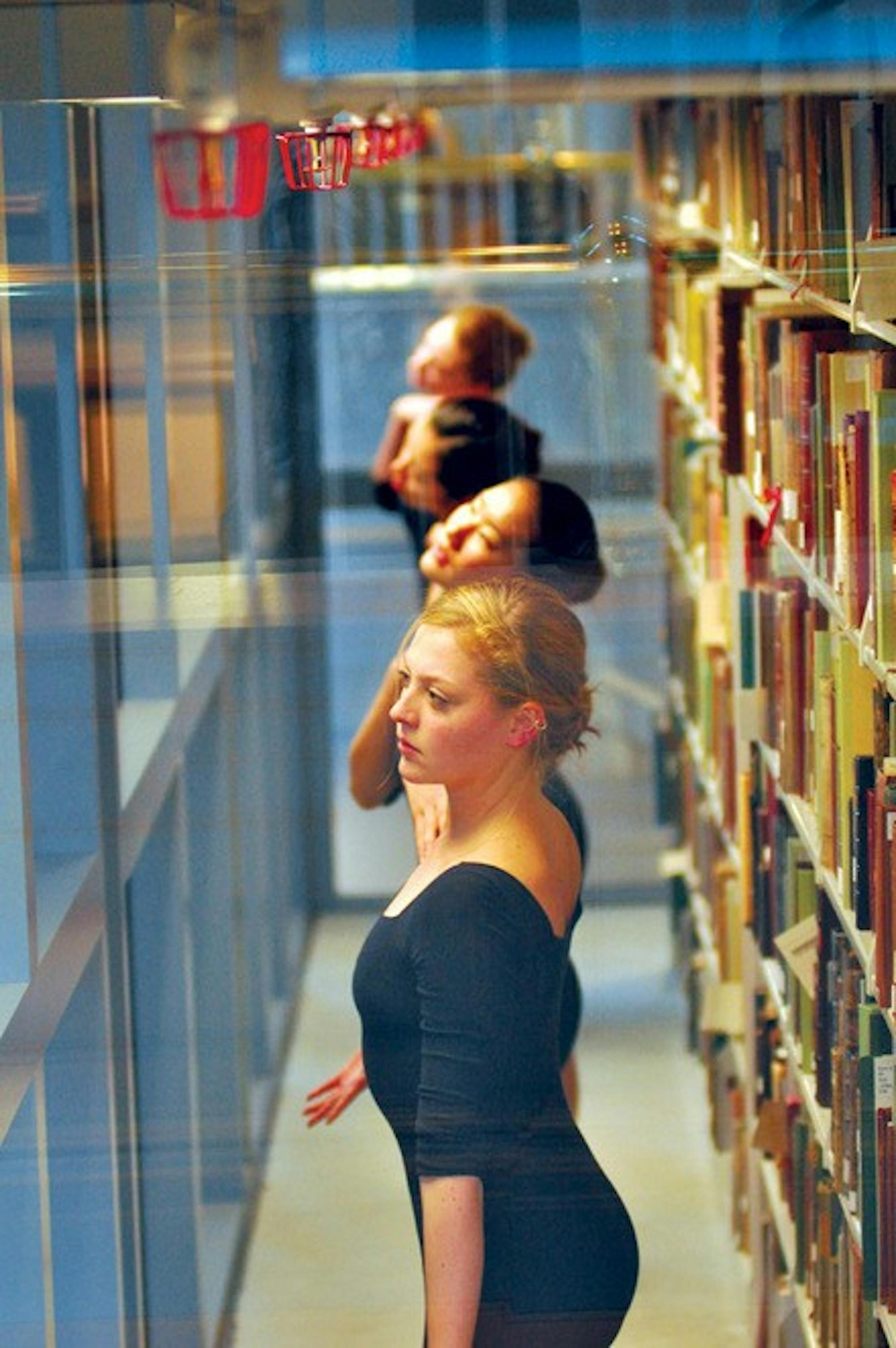The ensemble performed for an intimate audience that gathered around the balcony facing the Special Collections stacks. The performers warmed up in a corner of the balcony, then lined up to be led into the space by three librarians, for security. These librarians each stood in the corners of the three levels of the glass enclosure, each of which housed four dancers on each story. This intense security conveys the monumental nature of the ensemble being allowed behind the glass.
"I think everyone was really nervous," Mayuka Kowaguchi '11, the DDE member who served as the show's head choreographer, said in an interview with The Dartmouth. "I know one of my directors talked to the librarians before the show and asked them how they felt, and they were both excited but also really nervous."
The ensemble members each stood behind an individual pane of the glass, giving the performance a particular visual appeal from the start. The performance also lacked any sort of music, due to the librarians' wish to keep the show as integrated into the space and unobtrusive to library users as possible, according to Kowaguchi.
DDE member Elizabeth Hoffman '13 introduced the idea for a show in Rauner last year and also gained access to the special space in which they performed. According to Kowaguchi, the ensemble members were too busy to bring the idea to fruition last year, but it was something she wanted to pursue this term. When she visited Rauner Library to explore the space in the earliest stages of development this term, Kowaguchi said she was touched by anatomical images in Andreas Vesalius's book "De humani corporis fabrica" Latin for "On the structure of the human body."
"I really wanted it to not just be some arbitrary dance movement that we just put in the setting of Rauner, but I wanted it to be related to the space that we were in," Kowaguchi said. "I was incredibly moved by the beautiful images in the book, so I decided OK, maybe I can use that as the inspiration.'"
The three levels in the final performance each represented three different important aspects of the human body bones, skin and muscles. The top level represented bones, which the dancers portrayed using sharp, abrupt movements. The middle level represented skin, which the dancers beautifully depicted as fascinated with their own skin as they seemingly responded the urge to explore it with their hands. The bottom level represented muscles, the dancers using elongated poses and slow isolations that showed off their elegance.
According to Kowaguchi, when beginning the process of choreographing, she chose certain images from Vesalius's book to show her fellow dancers for inspiration. She said she was especially intrigued by successive drawings that depicted muscles being stripped from a body.
"I thought that idea of stripping away the human body from the outside down to the inside was really cool," Kowaguchi said. "So I had each of the three groups comes up with some sort of movement phrase that was inspired by the images and their topic."
The different movements of the levels were unified at some points in the show, yet in complete opposition at others, giving the audience something interesting and new to observe at all times. At times it was overwhelming to try to choose where to rest the eye for fear of missing something else. The silence of the performance gave it an appropriately eerie feel, as if observing the dissection of a body. The performance was impressive, especially considering the difficulty presented by the structure of the chosen space, and that Friday's performance was the first time the dancers had been inside the enclosure. The rehearsals all took place in a dance studio, according to Kowaguchi, who thought around the problem expertly.
"In our studio I took measurements of the three floors and we sort of taped off the exact measurements of those floors on three of the walls," Kowaguchi explained. "So the dancers rehearsed in those boxes, and that was how we limited the space so that they knew what kind of movement they could and couldn't do."
Despite the difficulty, the DDE certainly executed an amazing performance.
Projects like this will continue in the future, according to Kowaguchi. The group wants to further explore alternative spaces for art on campus, and even performed at the Organic Farm earlier in the term. Kowaguchi said that her interest is fueled in part by the inaccessibility of modern dance and her wish for students of the College to feel that they can understand performances.
"I'm trying to make this high art' accessible to the public, and especially having it in the library I think definitely makes it more accessible for students to enjoy," Kowaguchi said.
The Dartmouth Dance Ensemble will hold its main performance during the Spring term.




